|
observer |
|
|
|
|
|
OTHER LINKS |

|

|

|
ArtsPOINT OF VIEW: Nagenahira Veralen AsenaA panorama of Sri Lankan society at a microscopic levelThere are just a few good tele-dramas among those that have been telecast in Sri Lanka and most are serials that run for too long and are not upto quality standards in terms of content or technique. As a result many are of the view that you cannot deal with serious subjects in depth on TV.
Says Prof. Somarathne Balasuriya, the Chairman of the Censor Board of Sri Lanka on Nagenahira Veralen Asena, the latest tele-drama by award winning director and script writer Asoka Handagama. The story begins on December 26th 2004, as a group of youngsters from Colombo enjoy the beach in Ampara, on the East Coast. The Tsunami hits ashore devouring every object it meets with. Only two of the groups survive. The grief-stricken duo joins the massive relief effort launched in the aftermath of the calamity. A multi-ethnic refugee community representing a profile of Sri Lankan society thrown into a refugee camp put up in a Buddhist temple by the circumstances and the common plight in the aftermath of the devastating Tsunami, Nagenahira Veralen Asena explores the societal ills and the deep-seated misconceptions in the minds of diverse communities belonging to equally heterogeneous religions in a larger tapestry of multi-ethnic pluralistic Sri Lanka and the fanatic attempts made by few informed individuals, a light at the end of the tunnel, to rise above the trivial divides to achieve peace through dialogues and sharing the common bondage of humanity. Handagama's mastery in the craft of script-writing is amply demonstrated by close-knit situations and events exploring the ethnic, religious, caste and even regional prejudices and bias which had over the years become facts of life. A character of a narrow-minded Dhamma school teacher who had by-hearted distorted versions of history represents a petty-minded section of Sinhalese middleclass that place more value on superficial rituals and decorations than the essence of Buddhism epitomized by the Chief incumbent of the Temple. The Chief Incumbent or the Viharadhipathy of the temple portrayed fittingly by W. Jayasiri is an ideal Buddhist clergy who practises and understands the deep philosophy in Buddhism and condemns any attempt at igniting racial flames in the refugee camp housed in the temple premises. On the other hand, the Dhamma school teacher portrayed brilliantly by Lal Kularathne is the contrast of 'Loku Hamuduruwo' or the Chief Priest. Having by-hearted distorted versions of history, the school teacher unashamedly promotes racism. Having mistaken it for patriotism and nationalism, in a particular instance, he together with a militant Bhikku tries to incite people over a statue of Buddha that had been attacked by the terrorists. It was learnt that the statue had been planted at the junction by the same teacher against the advice of the Chief Incumbent. In Nagenahira Veralen Asena, Asoka Handagama has effectively overcome the limitations of teledrama which hitherto believed incapable of discussing complex human relations and portraying multitude of social issues and prejudices that have been deeply-imbedded in the alcove of communal psyche and surface only at times of violent confrontations among one another. It is obvious though the Sinhalese, Muslims and Tamils thrown into refugee camps by the common plight in the aftermath of the devastating Tsunami that deprived them of their kith and kin, deep in their psyche entertain their organic prejudices, biases and misconceptions against one another. A youth who has no kith and kin and uprooted from the social fabric, is seen throughout the teledrama filming the unfolding events. The youth symbolizes the generation of hapless individuals who have no caste race and identity, though the youngster was born and bred in Colombo. It is vaguely suggested that he was born Tamil but separated from his community in the upshot of communal riots; he speaks Sinhala, behaves as a Sinhalese and often reminds that race is also a label that is subconsciously attached to a child at birth. The character of this drifting soul is brilliantly portrayed by young actor Prageeth Rathnayake who had been triumphant in the characters portrayed throughout his career. The light at the end of the tunnel, in this artistic design, is that the only hope to break this vicious circle is to achieve lasting peace based on the mutual understanding of diverse communities and religions in a multi-ethnic pluralistic Sri Lanka. The teledrama is a commendable timely effort and should be watched by all those who aspire for a durable peace in a prosperous motherland. The cast comprised W. Jayasiri, Jagath Chamila, M.Kalaichelvan, P. Shanthi, Lal Kularatne, Gnei Raheem Saheed, Raja Ganeshan, Malcolm Machado, Mohammed Rauff, Gayani Hisanthika, Sanjaya Senanayake, Rebeka Nirmalie, Rukmal Nirosh, Prageeth Ratnayake, Thisara Jayawardena. Nagenahira Veralen Asena was directed by Asoka Handagama and produced by Young Asia Television. A doctorate for painter Jayasiri Semage
Ceylon Society of Arts (Lanka Kala Sangamaya) which is dedicated only for Painters of Sri Lanka has a record of 116 (one hundred and sixteen) years of existence. It is affiliated to the Ministry of Cultural Affairs. The Award Ceremony was held on September 22, 2006 at the Art Gallery, Colombo 7, The Hon. Minister of Cultural Affairs was the Chief Guest of the Awards Ceremony. 'Kala Suri' Jayasiri Semage has brought fame and glory to the Sri Lankan painting through national and international solo exhibitions at home and abroad. Semage's wall paintings are exhibited at Buddhist 'Vihares' in Singapore too. His paintings and decorations which have graced the 'Expo' exhibition stalls through the Sri Lankan Traditional Art Forms have been unique. Jayasiri Semage's pandals (thoran) and decorations at the 'Gam Udawa' and 'Maha Pola' Exhibitions including those for the State Festivals have earned him special attention from Sri Lankan art lovers. He is the only Sri Lankan artist and painter who had the privilege of exhibiting one of this paintings on a permanent basis in UNO in Geneva, Switzerland. Semage has won several Sri Lankan and International Awards including an award from Fukoka in Japan for erecting a pandal in Buddhist themes, "Kala Bhooshana" Award from Department of Cultural Affairs, Award from the International Media Foundation, Award of the U.N. Friendship Organization and the 'Kala Suri' Award from Sri Lanka's President. Semage has a unique style of painting which is a speciality among Sri Lankan artists. He was the President of the Ceylon Society of Arts in the years 2004 and 2005. Viveka
The exhibition which began on September 22, at the Lionel Wendt Art Gallery ends today. |
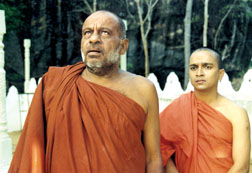 This has been proved wrong with this tele drama which brings up many
view points in relation to the national issue, religious issues,
fundamentalisms.. taken as a whole this series will shake viewers due to
our negative qualities, narrow thinking misconceptions among ethnic
groups - there is space for the discussion of such things within this
teledrama 'it is not just relating a story, it is addressing people's
minds and intellect.'
This has been proved wrong with this tele drama which brings up many
view points in relation to the national issue, religious issues,
fundamentalisms.. taken as a whole this series will shake viewers due to
our negative qualities, narrow thinking misconceptions among ethnic
groups - there is space for the discussion of such things within this
teledrama 'it is not just relating a story, it is addressing people's
minds and intellect.' 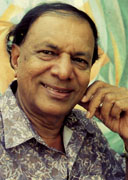 Nationally and Internationally famed Sri Lankan Artist Kala Suri
Jayasiri Semage has been awarded a "Doctorate of Arts" from the Ceylon
Society of Arts (Lanka Kala Sangamaya) This is the first time an
'Honorary Doctorate' has been awarded to a Sri Lankan Artist by the
Ceylon Society of Arts.
Nationally and Internationally famed Sri Lankan Artist Kala Suri
Jayasiri Semage has been awarded a "Doctorate of Arts" from the Ceylon
Society of Arts (Lanka Kala Sangamaya) This is the first time an
'Honorary Doctorate' has been awarded to a Sri Lankan Artist by the
Ceylon Society of Arts. 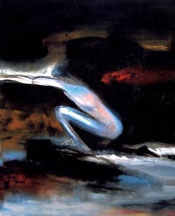
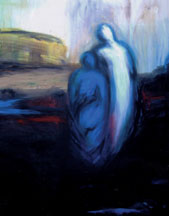
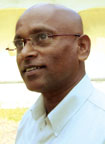 Gunasena Gamage, born in Wanduraba, Galle, having graduated from the
University of Kelaniya in 1974 and joined the Open University as a
Graphic Designer will be presenting the culmination of his twenty three
years as an artist in Viveka, which he describes as a journey in search
of spiritual tranquillity through creative visuals.
Gunasena Gamage, born in Wanduraba, Galle, having graduated from the
University of Kelaniya in 1974 and joined the Open University as a
Graphic Designer will be presenting the culmination of his twenty three
years as an artist in Viveka, which he describes as a journey in search
of spiritual tranquillity through creative visuals. 







